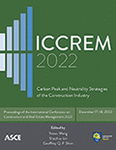A Framework for Measuring the Degree of Citizen Participation in Urban Village Reconstruction Projects
Publication: ICCREM 2022
ABSTRACT
During the rapid urbanization process in China, parts of the old urban areas are falling into decay. To revitalize the decaying area and improve the residents’ living quality, urban renewal has become an inevitable theme of urban development. During past decades, citizen participation in urban renewal has attracted considerable attention, for it can ensure social fairness and avoid conflicts among stakeholders in urban renewal projects. However, there is still a lack of a practical method to quantify the degree of citizen participation of urban renewal projects. To fill this gap, this paper develops a framework to measure the degree of citizen participation from the dimensions of breath and depth, which were measured based on the approaches of participation and types of stakeholders involved, and were measured based on Arnstein’s ladder of citizen participation, respectively. Finally, the application of this framework was illustrated through a case study on an urban village reconstruction project in Guangzhou, denoting its applicability in quantifying the degree of citizen participation in urban village reconstruction projects.
Get full access to this article
View all available purchase options and get full access to this chapter.
REFERENCES
Arnstein, S. R. (2019). “A ladder of citizen participation.” Journal of the American Planning Association, 85(1), 24–34.
Day, D. (1997). “Citizen participation in the planning process: An essentially contested concept?” Journal of Planning Literature, 11(3), 421–434.
Enserink, B., and Koppenjan, J. (2007). “Public participation in China: Sustainable urbanization and governance.” Management of Environmental Quality: An International Journal, 18(4), 459–474.
Freeman, R. E. (1984). “Section 1: The stakeholder approach.” Strategic management: A stakeholder approach, Cambridge university press, New York, 1.6.
Fung, A. (2006). “Varieties of participation in complex governance.” Public Administration Review, 66, 66–75.
Jiang, Y. P., Mohabir, N., Ma, R. F., Wu, L. C., and Chen, M. X. (2020). “Whose village? Stakeholder interests in the urban renewal of Hubei old village in Shenzhen.” Land Use Policy, 91, 104411.
Kartam, N. A. (1996). “Making effective use of construction lessons learned in project life cycle.” Journal of Construction Engineering and Management, 122(1), 14–21.
Lai, S. K., Ding, C., Tsai, P. C., Lan, I. C., Xue, M., Chiu, C. P., and Wang, L. G. (2008). “A game-theoretic approach to urban land development in China.” Environment and Planning B: Planning and Design, 35(5), 847–862.
Lang, W., Chen, T. T., and Li, X. (2016). “A new style of urbanization in China: Transformation of urban rural communities.” Habitat International, 55, 1–9.
Li, X., Hui, E. C. M., Chen, T. T., Lang, W., and Guo, Y. L. (2019). “From Habitat III to the new urbanization agenda in China: Seeing through the practices of the ‘three old renewals’ in Guangzhou.” Land Use Policy, 81, 513–522.
Lin, Y. L., Hao, P., and Geertman, S. (2015). “A conceptual framework on modes of governance for the regeneration of Chinese ‘villages in the city’.” Urban Studies, 52(10), 1774–1790.
Liu, G. W., Wei, L. Z., Gu, J. P., Zhou, T., and Liu, Y. (2020). “Benefit distribution in urban renewal from the perspectives of efficiency and fairness: A game theoretical model and the government’s role in China.” Cities, 96, 102422.
Liu, Y., Tang, S. S., Geertman, S., Lin, Y. L., and van Oort, F. (2017). “The chain effects of property-led redevelopment in Shenzhen: Price-shadowing and indirect displacement.” Cities, 67, 31–42.
Liu, X. K. (2017). “On the degree of public participation in administrative decision-making and its influential factors: Based on the analysis of Chinese experience.” Journal of Beijing Administration Institute, (4), 54–62. (in Chinese).
Meng, D., and Liu, G. P. (2005). “Study on appraisement system of the public participation in city planning.” Journal of Southeast University (Natural Science Edition), (s1), 241–246. (in Chinese).
Roberts, N. C. (2008). “Section 1: Direction citizen participation: challenges and dilemmas.” The Age of Direct Citizen Participation, Routledge, New York, 1.3.
Rongerude, J. M., and Christianson, E. (2014). “Network analysis of affordable housing organizations in Polk County.” <https://dr.lib.iastate.edu/server/api/core/bitstreams/45cde11a-5119-4688-b4e3-5c21fc53ab7b/content>(Jun.1, 2022).
Sanoff, H. (1999). “Section 1: Participation purposes.” Community Participation Methods in Design and Planning, John Wiley & Sons, New York, 1.3.
Wang, X. H., and Van Wart, M. (2007). “When public participation in administration leads to trust: An empirical assessment of managers’ perceptions.” Public Administration Review, 67(2), 265–278.
Wilson, J. Q. (1963). “Planning and politics: Citizen participation in urban renewal.” Journal of the American Institute of Planners, 29(4), 242–249.
Xu, X. Z., and Akita, N. (2021). “Demolition/reconstruction, and comprehensive renovation? Reflections on the renewal of urban villages in North China: A case study of a Beijing urban village.” International Review for Spatial and Planning and Sustainable Development, 9(2), 62–75.
Zhao, Y. Q., An, N., Chen, H. L., and Tao, W. (2021). “Politics of urban renewal: An anatomy of the conflicting discourses on the renovation of China’s urban village.” Cities, 111, 103075.
Zheng, X., Le, Y., Chan, A. P. C., Hu, Y., and Li, Y. K. (2016). “Review of the application of social network analysis (SNA) in construction project management research.” International Journal of Project Management, 34(7), 1214–1225.
Zhuang, T. Z., Qian, Q. K., Visscher, H. J., Elsinga, M. G., and Wu, W. D. (2019). “The role of stakeholders and their participation network in decision-making of urban renewal in China: The case of Chongqing.” Cities, 92, 47–58.
Information & Authors
Information
Published In
History
Published online: Dec 15, 2022
Authors
Metrics & Citations
Metrics
Citations
Download citation
If you have the appropriate software installed, you can download article citation data to the citation manager of your choice. Simply select your manager software from the list below and click Download.
